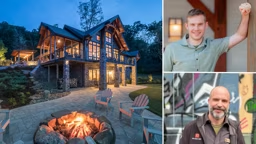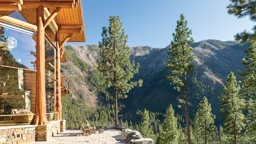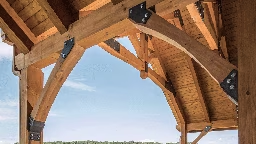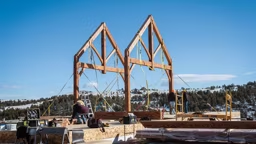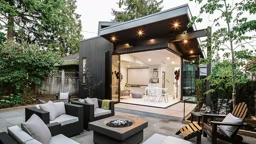
Photo: Aleksandar Radovanovic / Unsplash
Wood species vary in their color and characteristics (for example, knots versus clear-grain) and play a huge part in the way your timber home looks and lives. Ask each timber provider you’re considering for more information about the types of wood the company works with. The most common species are oak, pine, fir, hemlock and cedar.
In addition to the species of wood, moisture content will affect how it performs once the timber frame is assembled. Here are a few of the basic choices:
Green Wood
Green timbers are fresh from the forest. They have a high moisture content (30 percent or more), making them easy for timber framers to craft since they’re easier to cut. Green timbers also have the advantage of being the most economical option because they’re less expensive than other varieties that require additional handling and preparation.
Green timbers have a lot of drying to do — and all of it will be done after they’re crafted into your home. As it dries, green wood will check (crack), particularly when the weather turns cold and you turn on your furnace, thereby accelerating the drying process. Fortunately, checking won’t impact the structural integrity of your home, if it’s properly planned and built. Standing-dead Timber
Standing-dead timbers are trees that were killed by insect infestation, fire or other means, causing them to dry out while still standing in the forest. Before you balk at the thought of building with bug-ridden trees, rest assured that once the tree is dead, the pests, finding themselves without a food source, have moved on. With its low moisture content, this type of wood is more stable and less prone to checking or twisting than green timber. Standing-dead timber does cost more than green timber, because it’s less plentiful and usually harvested selectively.
Air- or Kiln-dried
To reduce the amount of movement of the frame as it dries, some timber-home companies use air- or kiln-dried posts and beams. Large kilns dry the timbers over the course of several weeks, reducing the moisture content to around 18 to 20 percent. Air-dried timbers are left in log yards for several months to years to reach similar moisture content. Either way, you’ll pay more for a dried timber than you would for green wood because of this additional investment in time and resources.
Reclaimed Wood
If you’re looking for wood with a rich history, consider reclaimed timbers harvested from carefully dismantled, centuries-old factories, barns, bridges and piers. Some companies even have discovered huge old-growth trees no longer found in forests by dredging rivers and lakes near the sites of sawmills of yesteryear. Because these large posts and beams have been seasoned for so long, they are extremely hard and stable. But because it’s more difficult to obtain and process reclaimed
timbers, companies typically charge a premium for this product. See Also: Are Exotic Hardwoods Worth the Cost?
Curious about the appearance of each variety? Here, a concise guide to the aesthetics to look for with each:
Douglas Fir

Western Red Cedar

Eastern Hemlock

Red Oak

Eastern White Pine

Heartwood Colors: Creamy white to light brown, often with a reddish tinge




